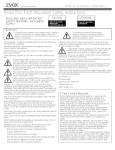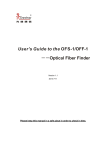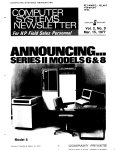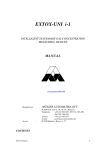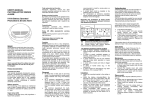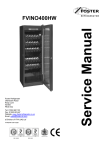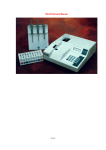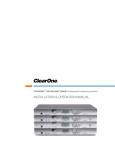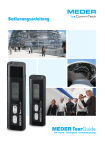Download User Manual Rescue Radar
Transcript
User Guide Life detection with RescueRadar 2 MEDER RescueRadar Table of contents Table of contents 1. Locate life – Save lives................................................................. 4 1.1 The function, the most important briefly................................. 4 1.2 Range of applications........................................................... 5 2. Scope of delivery / device parts.................................................. 6 3. Bringing into Service.................................................................... 7 4. Operating state............................................................................ 8 4.1 Changing the accumulators.................................................. 8 4.2 Charging the accumulators................................................... 8 4.3 Charging device – note on safety......................................... 8 4.4 Accumulators – note on safety.............................................. 8 5. The first measurement.................................................................. 9 5.1 Preparative............................................................................ 9 5.2 Start....................................................................................... 9 5.3 Finish..................................................................................... 9 www.meder-commtech.com 3 MEDER RescueRadar Table of contents 6. Software description..................................................................11 6.1 Shortcuts............................................................................ 12 6.2 Analysis options..................................................................13 7. Measurement examples and their interpretation.......................15 8. Technical Data............................................................................18 8.1 Radar unit........................................................................... 18 8.2 Power supply.......................................................................18 8.3 Coupling to the notebook / PC............................................18 8.4 Dimensions and weight.......................................................18 9.FAQs...........................................................................................19 www.meder-commtech.com 4 MEDER RescueRadar The function 1. Locate life – Save lives The Life RescueRadar BR 502w is a high-tech equipment to detect and evaluate movements of creatures, primarily human beings. 1.1 The function, the most important briefly The system works with electromagnetic waves through obstacles. The antenna transmittes radar waves, which are received and evaluated by the Life RescueRadar. By this way body movements, breathing and heartbeat activities can be detected and evaluated. Through analysis of the received signals it is possible to prove immediately and with high probability the presence of life in front of the antenna. The Life RescueRadar can detect through all dielectrical materials, such as brick or concrete construction, layers of sand, debris, soil, snow up to a thickness of several meters. The only but necessary requirement for normal functioning of the system is that there is no conductive shielding between the antenna and the person who is to be located. Parts of metal (steel inside concrete) may cause a loss of sensitivity of the Life RescueRadar. Within a very short period of time the computer analysis provides you with a detailed definition of the information. Every standard PC with a 32-bit Windows operating system is suitable. The used amount of radiation is harmless for all creatures because of its low power. www.meder-commtech.com 5 MEDER RescueRadar Range of applications 1.2 Range of applications According to the function described above the following fields of operation are possible: • Search for buried persons after disasters (rescue services) • Detection of persons inside buildings from outside (building security) • Detection of movements in underground nonmetallic channels and cavities • Detection of hidden persons in cars and trucks (customs, multistorey car parks, prisons) Search for buried persons after disasters (rescue services). Detection of persons inside buildings from outside (building security). Detection of movements in underground cavities. Detection of hidden persons in cars and trucks (customs, multistorey car parks, prisons). www.meder-commtech.com 6 MEDER RescueRadar Delivery / device parts 2. Scope of delivery / device parts The whole system is delivered in a Pelicase, which usually serves as workplace. The equipment consists of following components: • 1 Casing (Pelicase) 1 • 1 Radar unit 2 The radar unit includes the entire RF-electronics from the antenna to the demodulator circuit, also the wireless-transmitter unit. The operating range is up to 30 m. • 1 Wireless-receiver with connector cable to the PC 3 • 1 Charging device including additional manual 4 • 10 pieces 1,5 V batteries (size AA / LR6) • 1 Operating and interpretation software • 1 User Manual The dimensions of the antenna are 250 mm x 300 mm. The power supply is made very flexibly for working under field conditions. It is possible to use rechargable or non-rechargable batteries. The necessary notebook / PC is not included in the standard version of Life RescueRadar. It may be optionally added. 1 4 2 Figure 1: RescueRadar BR 502w www.meder-commtech.com 3 7 MEDER RescueRadar Starting 3. Starting 1. Copy the files BioRadar Analyser.exe and BioRadar Analyser.ini to a common folder. Open the file BioRadar Analyser.ini (e.g. with editor) and enter the value „x“ of the IP-address 197.1.1.x, stated on the wireless receiver, in „IpAddr“. The other default parameters should not be changed. 2. Open Network Connections, under Settings in the Windows Start menu, and select the LAN connection the wireless receiver is connected to. Open the properties of the LAN connection by right click and open the properties of Internet Protocol (TCP/IP). Choose the button “Advanced…” and add a new IP-address in the tab “IP addresses“: IP adresse: Subnet mask: 197.1.1.nn (nn >10) 255.255.255.0 3. Before starting, be sure that the accumulator stack in the radar unit is fully charged and the radar unit is switched off. 4. Connect the wireless-receiver with the provided cables (Ethernet, USB) to the PC. 5. Switch on the radar unit. The little green LED built in the handle turns on. 6. The green LED turns on when the radar unit is connected with the wireless receiver. www.meder-commtech.com 8 MEDER RescueRadar Operating state 4. Operating state If the input voltage is lower than 10 V., there will be an error message in the status window, please change the accumulators or batteries. 4.1 Changing the accumulators 1. Switch off the radar unit. There is no need to switch off the PC. 2. Remove the accumulator stack and insert the second one. 3. Switch on the radar unit. 4.2 Charging the accumulators For charging the accumulators, a 100 - 240 V AC; 60 / 50 Hz power supply is required. A complete charging process of a totally discharged accumulator takes about 14 hours time. The accumulator is totally charged when the green LED at the charging device turns on. Depending on the type of accumulator, it must be fully discharged before recharging. 4.3 Charging device – note on safety For detailed information please refer to added operating instructions of the charging device. 4.4 Accumulators – note on safety 1. Do not bridge the poles of the accumulators. 2. The not throw accumulators or batteries in your domestic waste bin. Please recycle! ≈ 100 m free field conditions! www.meder-commtech.com 9 MEDER RescueRadar The first measurement 5. The first measurement 5.1 Preparative • Place the antenna directly onto/abve the area you want to investigate. The better the contact of the antenna to the surface the less is the chance to collect unwanted signals. • Run the RescueRadar software. • On the desktop you see figure 2. To check normal function of the equipment it runs continuously a „Self Check” function. The arrows of the analogue displays in the status window (Input voltage, Internal voltage, Radar unit and Compensation) have to be in the green area. This process starts after getting a new antenna position and needs some seconds. 5.1 Start • Data acquisition starts by mouse click on the button with the magnifying glass or by shortcut (shortcuts see page 12). The measured signal is displayed from right to left inside the window signal view. After a short time the evaluations are displayed inside the windows Fourier analysis view and wavelet analysis view. The analogue display of Compensation inside the window status window must be in the green area. It shows the operator the adaptation status of the antenna. The radar unit automatically adapts to the surface in front of it. This process starts after setting a new antenna position and needs some seconds. During this time the displayed signal of compensation is outside the green area and the measured data is useless. A strong movement in front of the antenna can cause a readaption of the system. • If the display of Compensation after 10 – 15 seconds is still outside the green area, displace the antenna about few centimetres. The data acquisition runs continuously, also the Fourier and wavelet analysis (see figure 3). 5.3 Finish • Click on the button with the magnifying glas. The last 56 seconds of data will be displayed and can be recorded with a comment. www.meder-commtech.com 10 MEDER RescueRadar Interface Figure 2: Windows user interface Figure 3: display of the measuring data www.meder-commtech.com 11 MEDER RescueRadar Software description 6. Software description The measured data are displayed under the 32-bit software written for Windows. It requires at least a 133 MHz Pentium CPU. The processor performance has no influence on the quality of the measuring values. The measured data and mathematical results are displayed constantly and simultaneous in four windows (see figure 3): • signal view • Fourier analysis view • wavelet analysis view • status window Menu buttons: Open Description editor Save Setup window Acquisition emulation Start/Stop simulation About Signal acquisition Start/Stop measuring Exit BioRadar Analyser Print results All commands are possible to run by mouse or key operations. www.meder-commtech.com 12 MEDER RescueRadar Shortcuts 6.1 Shortcuts Mouse click Shortcut Description of operation File Open [Ctrl] + [O] Save [Ctrl] + [S] Print [Ctrl] + [P] Export [Ctrl] + [R] Exit [Ctrl] + [F4] [Ctrl] + [X] open an already saved data file save the recent file together, with added comments print the open file, results and comments save the recent file in ASCII format quit the RescueRadar software View opens a text window where you can add your comments Description [Ctrl] + [D] Data Acquisition [Ctrl] + [A] Emulation [Ctrl] + [E] start or stop the data acquisition mode start or stop the demonstration mode Options setting of parameters Setup www.meder-commtech.com 13 MEDER RescueRadar Analysis-options 6.2 Analysis-options: signal view Data acquisition starts by mouse click on the button with the magnifying glas or by shortcut - [Ctrl]+[A] The incoming data are displayed continuously from right to left (oscilloscopelike) inside the window signal view. The scale of this window is set automatically depending on incoming amplitude during the acquisition. The red and green lines show movements detected by the antenna. If both lines are flat, there is either no movement or no penetration is possible. For deeper understanding of the influencing variables training and experience is essential. For finishing the acquisition, click on the button with the magnifying glas or use the shortcut - [Ctrl]+[A]. The data of the last measuring period is displayed and ready for further operations. It is possible to cut (set to zero) unwanted parts of signal by marking them with the left mouse button. You update the wavelet analysis with a double click of the left mouse button within the window wavelet analysis. Fourier analysis view Accumulates the sums of the amplitudes of the single frequencies over the time period as displayed by the wavelet. The result is updated constantly. A high peak indicates a dominant frequency over a long time period. www.meder-commtech.com 14 MEDER RescueRadar Analysis-options wavelet analysis view Is a kind of graphic display showing the frequency spectrum of the current analogue signal in online mode. The diagram is displayed in three dimensions as a function of the time and displayed in the window wavelet analysis view. · First dimension: Time axis (horizontally) at the same time to the time axis in the window signal view · Second dimension Frequency (vertically) high frequencies in the top of the window, low frequencies in the bottom of the window · Third dimension Amplitude of the frequency spectrum is shown by different colour and brightness values; dark for low amplitude, bright for high amplitude status window The status window is a set of gauges displaying the current electrical conditions of accumulator (Input voltage), proper function of internal electronics (Internal voltage), power consumption of the radar unit (Radar unit) and the compensation signal value of new local conditions (Compensation). After detection of a constant frequency during the time defined in the settings the Life indicator lights up. The amplitude is irrelevant. www.meder-commtech.com 15 MEDER RescueRadar Bedienungsanleitung Example1 7. Measurement examples and their interpretation Example 1 Example 1 displays a possible RescueRadar signal, the pertinent spectrums of the Fourier analysis and the wavelet analysis. It shows a clear breathing of a person. Typical breathing frequencies are in the range between 0,15 and 0,8 Hz. The Fourier analysis shows a dominant frequency of 0,26 Hz. This equals a Bedienungsanleitung breathing rate of approx. 15 times per minute. The wavelet analysis shows, that the dominant frequency was present over the entire measuring period. Result: The scale of 2 V, shown in the signal view, indicates a strong echo. Weiteres Vorgehen: The Life indicator is activated. The received echo matches biological patterns, gt keine deutlichen rhythmischen Anteile. life is very likely. Frequenzbereich von etwa 0,3 bis 0,4 Hz lässt eine deren Ursache menschliche Atmung sein könnte, www.meder-commtech.com Analyse zeigt keine über längere Zeit vorhandene Bewegung. Der Life indicator reagiert nicht. Ändern Sie die Position bzw. die Richtung der Anten Schritten und wiederholen Sie die Datenerfassung, • um ein besseres Signal zu erhalten • um festzustellen, ob tatsächlich eine Atmung nach Bedienungsanleitung 16 MEDER RescueRadar Example 2 Example 2 shows irregular signals. In spite of the chaotic signals Fourier is able to detect the dominant frequency of 0,3 to 0,4 Hz. The wavelet analysis shows scattered frequency occurrences but no constant dominant frequency over the time period. The Life indicator does not react. Bedienungsanleitung Result: Movement is detected. But the probability of a human breathing is rather low. Other action: Change the position or direction of the antenna in small Ergebnis: steps and repeat the data acquisition: gene Signal ist rhythmisch mit einer kleinen Ampli· to get a better signal ab 0,25 V). Menschliche Atmung wurde unter günstigen Bedin kleiner Amplitude sind wenig Störungen sichtbar) ge pitze bei 0,4 Hz im Fenster Fourier-Analyse befindet ch der Atmung. Die Spitze liegt bei 0,4 Hz. · to ensure the probability of human life -Analyse zeigt deutlich das Vorhandensein der Fre0,4 Hz über den gesamten Zeitraum. www.meder-commtech.com cator leuchtet. Bedienungsanleitung 17 MEDER RescueRadar Example 3 Example 3 The received signal is rhythmical with small amplitude (scale 0,25 V) over the entire measured period. The Fourier analysis shows a dominant frequency at 0,4 Hz. Also the wavelet analysis shows the dominant frequency over the entire period. The Life indicator is activated. Bedienungsanleitung Result: Biological patches where found under difficult conditions. The signals where very low (scale 0,25 V) but there where no additional noices nischedetected. Daten eil enz: eit: enne: 8.3 Kopplung zum Notebook / PC 1299 MHz < 2 mW (diese Leistung ist für den Betreiber ungefährlich) keine (Dauerstrichradar) -90 dBm (S/N = 10 dB) www.meder-commtech.com fest integriert im Radarteil 250 mm x 300 mm x 60 mm Empfängerbox: Software: Notebook / PC: LAN (TCP/IP) und USB versorgung) mit IP-Adresse: (nn > 10) BioRadar Analyser für Window / Vista / 7; zur Erfassung und der Messwerte auf Speicherung auf Festplatte Datenträger, Ausgabe auf Dru Office-Anforderungen, keine s forderungen 18 MEDER RescueRadar Technical Data 8. Technical Data 8.1 Radar unit Transmitting unit Operation frequency: RF output: Modulation: 1299 MHz < 2 mW no modulation (continuous wave radar) Receiving unit Sensitivity: Antenna: Dimensions: Operating position: Direction of radiation: Spread angle: -90 dBm (S/N = 10 dB) permanently integrated in the radar unit 250 mm x 300 mm x 60 mm optional vertical to the surface 250 x 300 approx. 55 ° 8.2 Power supply Operating voltage: Power consumption: accumulator stack 12 V, 10x NiMh (size AA/LR6); > 2 Ah; 2 accumulator stacks (removable) Charging device for 100 – 240 V approx. 4 W (without Notebook / PC) 8.3 Coupling to the notebook / PC Wireless receiver: Software: Notebook / PC: LAN (TCP/IP) and USB (power supply) with IP-address: 197.1.1.nn (nn > 10) BioRadar Analyser for Windows 2000 / XP/ Vista / 7; software to record and evaluate the measured values on the monitor, storage on hard disk or mobile volume and printing Office-standards, no special requirements Outdoor design is recommended 8.4 Dimensions and weight Casing:Pelicase Dimensions: Width: 530 mm; Height: 420 mm; Depth: 220 mm Weight: approx. 12 kg www.meder-commtech.com 19 MEDER RescueRadar FAQs 9. FAQs Q: Can the RescueRadar be operated by a single person? A: Yes, it is easy to transport and operate. A second person might increase the effectiveness. Q: Is the emitted radiation dangerous? A: No, the emitted radiation is less 2mW. In fact it is about 1% of the emittation of a cell phone. Q: Can the RescueRadar find out how many persons are buried? A: No, multiple persons might cause a lot of signals in various frequency ranges. But the exact number can not be read out. Q: Does the RescueRadar provide distance to object? A: No, the RescueRadar is not using pulsed and swooping signals. Q: What is the opening angle of the radar beam? A: The opening angle is 55°. With this angle the center of the beam provides about 50% sensitivity in the center of the beam. Q: Is a PC or Laptop required? A: Yes, the signal processing and the display of the measurements are shown on the screen. Q: Is it necessary to understand all diagrams on the screen? A: The displays help to get a deeper understanding of the location of a person. But the software does also show by a simple life indicator if biological signals are found. Q: Is the PC/ Laptop part of the bundle? A: We offer different bundles without Laptop and also including Laptop. Q: What is the working Principe of the RescueRadar? A: The RescueRadar is working with micro wave radar and uses Doppler effect for detection Q: What kind of signals is the RescueRadar detecting? A: The RescueRadar detects only movements not static echo‘s. This can be returning movements like breathing or heartbeat as well as one time actions like a moving person. Q: What does effect the signal strength? A: The signals are depending on the distance from object to antenna, the isolating properties of the material and the size of the moving surface. Q: What detection range has the BR? A: Mainly depending on the material to penetrate from 30m in air, to about 1m in armed concrete down to zero for wet materials like mud. Q: What is the used frequency range? A: The frequency is 1299 MHz with bandwidth of nearly zero. www.meder-commtech.com MEDER CommTech GmbH This dcoument can be downloaded at: Robert-Bosch-Straße 4www.meder-commtech.com 78224 Singen / Htwl. Deutschland Telefon: +49 (0) 7731 911 322 0 Telefax: +49 (0) 7731 911 322 99 [email protected] www.meder-commtech.com
























